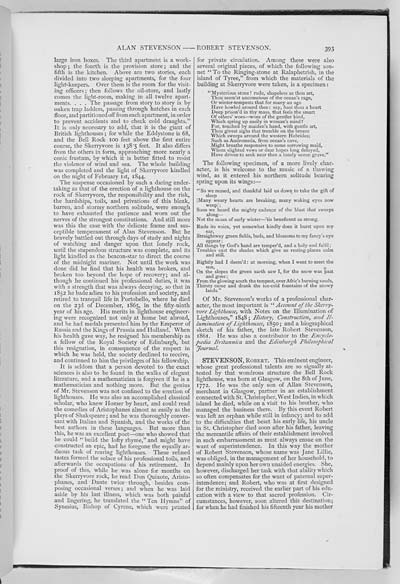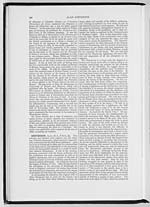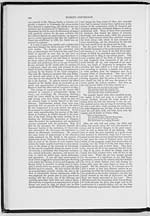Volume 3 > Half-Volume 6
(39) Page 393 - Stevenson, Robert
Download files
Individual page:
Thumbnail gallery: Grid view | List view

393 large iron boxes. The third apartment is a work- shop ; the fourth is the provision store; and the fifth is the kitchen. Above are two stories, each divided into two sleeping apartments, for the four light>keepers. Over them is the room for the visit- ing officers; then follows the oil-store, and lastly comes the light-room, making in all twelve apart- ments. . . . The passage from story to story is by oaken trap ladders, passing through hatches in each floor, and partitioned off from each apartment, in order to prevent accidents and to check cold draughts." It is only necessary to add, that it is the giant of British lighthouses; for while the Eddystone is 68, and the Bell Rock 100 feet above the first entire course, the Skerryvore is 138�5 feet. It also differs from the others in form, approaching more nearly a conic frustum, by which it is better fitted to resist the violence of wind and sea. The whole building was completed and the light of Skerryvore kindled on the night of February 1st, 1844. The suspense occasioned by such a daring under- taking as that of the erection of a lighthouse on the rock of Skerryvore, the responsibility and the risk, the hardships, toils, and privations of this bleak, barren, and stormy northern solitude, were enough to have exhausted the patience and worn out the nerves of the strongest constitutions. And still more was this the case with the delicate frame and sus- ceptible temperament of Alan Stevenson. But he bravely battled out through days of study and nights of watching and danger upon that lonely rock, until the stupendous structure was complete, and its light kindled as the beacon-star to direct the course of the midnight mariner. Not until the work was done did he find that his health was broken, and broken too beyond the hope of recovery; and al- though he continued his professional duties, it was with a strength that was always decaying, so that in 1852 he bade adieu to his profession and society, and retired to tranquil life in Portobello, where he died on the 23d of December, 1865, in the fifty-ninth year of his age. His merits in lighthouse engineer- ing were recognized not only at home but abroad, and he had medals presented him by the Emperor of Russia and the Kings of Prussia and Holland. When his health gave way, he resigned his membership as a fellow of the Royal Society of Edinburgh, but this resignation, in consequence of the respect in which he was held, the society declined to receive, and continued to him the privileges of his fellowship. It is seldom that a person devoted to the exact sciences is also to be found in the walks of elegant literature, and a mathematician is forgiven if he is a mathematician and nothing more. But the genius of Mr. Stevenson was not confined to the erection of lighthouses. He was also an accomplished classical scholar, who knew Homer by heart, and could read the comedies of Aristophanes almost as easily as the plays of Shakspeare; and he was thoroughly conver- sant with Italian and Spanish, and the works of the best authors in these languages. But more than this, he was an excellent poet�one who showed that he could "build the lofty rhyme,"and might have constructed an epic, had he foregone the equally ar- duous task of rearing lighthouses. These refined tastes formed the solace of his professional toils, and afterwards the occupations of his retirement. In proof of this, while he was alone for months on the Skerryvore rock, he read Don Quixote, Aristo- phanes, and Dante twice through, besides com- posing occasional verses; and when he was laid aside by his last illness, which was both painful and lingering, he translated the " Ten Hymns" of Synesius, Bishop of Cyrene, which were printed for private circulation. Among these were also several original pieces, of which the following son- net " To the Ringing-stone at Ralaphetrish, in the island of Tyree," from which the materials of the building at Skerryvore were taken, is a specimen: "Mysterious stone! rude, shapeless as thou art, Thou seem'st unconscious of the ocean's rage, Or winter-tempests that for many an age Have howled around thee: say, hast thou a heart Deep prison'd in thy mass, that feels the smart Of others' woes�woes of the gentler kind, Which spring up easily in woman's mind? For, touched by maiden's hand, with gentle art, Thou givest sighs that tremble on the breeze Which sweeps around the western Hebrides; Such as Andromeda, from ocean's cave, Might breathe responsive to some sorrowing maid, Whom slighted vows or dear hopes long delayed, Have driven to seek near thee a lonely ocean grave." The following specimen, of a more lively char- acter, is his welcome to the music of a thawing wind, as it entered his northern solitude bearing spring upon its wings:� "So we mused, and thankful laid us down to take the gift of sleep (Many weary hearts are breaking, many waking eyes now weep); Soon we heard the mighty cadence of the blast that sweeps along� Not the moan of surly winter�'tis beneficent as strong. Rude its voice, yet somewhat kindly does it burst upon my ear, Straightway green fields, buds, and blossoms to my fancy's eye appear; All things by God's hand are temper'd, and a holy end fulfil; Troubles cast the shades which give us resting-places calm and still. Rightly had I deem'd: at morning, when I went to meet the sun, On the slopes the green earth saw I, for the snow was past and gone; From the glowing south the tempest, over Afric's burning sands, Thirsty came and drank the ice-cold fountains of the snowy lands." Of Mr. Stevenson's works of a professional char- acter, the most important is " Account of the Skerry- vore Lighthouse, with Notes on the Illumination of Lighthouses," 1848; History, Construction, and Il- lumination of Lighthouses, 1850; and a biographical sketch of his father, the late Robert Stevenson, 1861. He was also a contributor to the Encyclo- p�dia Britannica and the Edinburgh Philosophical Journal. STEVENSON, ROBERT. This eminent engineer, whose great professional talents are so signally at- tested by that wondrous structure the Bell Rock lighthouse, was born at Glasgow, on the 8th of June, 1772. He was the only son of Allan Stevenson, merchant in Glasgow, partner in an establishment connected with St. Christopher, West Indies, in which island he died, while on a visit to his brother, who managed the business there. By this event Robert was left an orphan while still in infancy; and to add to the difficulties that beset his early life, his uncle in St. Christopher died soon after his father, leaving the mercantile affairs of their establishment involved in such embarrassment as must always ensue on the want of superintendence. In this way the mother of Robert Stevenson, whose name was Jane Lillie, was obliged, in the management of her household, to depend mainly upon her own unaided energies. She, however, discharged her task with that ability which so often compensates for the want of paternal super- intendence; and Robert, who was at first designed for the ministry, received the earlier part of his edu- cation with a view to that sacred profession. Cir- cumstances, however, soon altered this destination; for when he had finished his fifteenth year his mother
Set display mode to:
![]() Universal Viewer |
Universal Viewer | ![]() Mirador |
Large image | Transcription
Mirador |
Large image | Transcription
Images and transcriptions on this page, including medium image downloads, may be used under the Creative Commons Attribution 4.0 International Licence unless otherwise stated. ![]()
| Biographical dictionary of eminent Scotsmen > Volume 3 > Half-Volume 6 > (39) Page 393 - Stevenson, Robert |
|---|
| Permanent URL | https://digital.nls.uk/74514352 |
|---|---|
| Attribution and copyright: |
|
| Description | Volume III. Contains names alphabetically from Macadam to Young. |
|---|

